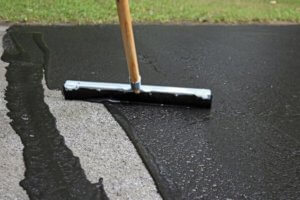If your Northern Virginia home has an asphalt driveway, or you have an asphalt parking lot at your business, sealcoating is an important maintenance process that can significantly extend the life of your asphalt surface. While asphalt is the best paving choice with the highest value for many applications, it’s important to remember what it’s made of.
Asphalt is a mix of stone and gravel held together with a binder. That binder is asphalt cement, a petroleum product created by refining several types of crude oil. Because asphalt is a chemical product, it’s subject to degrading when exposed to excessive UV, other chemicals like automotive fluids and deicers, and even excessive water. In Fairfax, Arlington, and Loudoun counties, we get plenty of Northern Virginia weather which brings us plenty of damaging sun, leaky cars, trucks, and SUVs, snow, and rain.
In other words, asphalt driveways and parking lots lead a pretty tough life in Northern Virginia.
How Sealcoat Can Extend the Life of Your Asphalt Driveway or Parking Lot
A high-quality sealcoating (like the one we use at Standard Paving) can extend the life of your asphalt by nearly double. It’s a relatively fast process involving minimal inconvenience, and it is far less expensive than having to repave a surface. Applying it every two or three years will pretty much ensure you’ll get 20 to 30 years out of your driveway or parking lot.
Sealcoat is typically bituminous or acrylic based mixed with water, silica sand, and polymer additives. This liquid mix is brushed on or squeegeed on, and when it dries (typically after 24 hours) provides protection for the asphalt from the climate and manmade chemicals. In addition to protection, sealcoating gives your asphalt a slip resistant character and a beautiful slate black appearance.
When Should You Apply Sealcoating?
There’s two ways to answer this question. The first question is really how do I know I need sealcoating? If your asphalt driveway is showing signs of becoming brittle (flaking and shallow cracks) its time. Or you can just consider sealcoating as recommended scheduled maintenance like an oil change and just schedule it to be done once every two or three years. If you have questions on the direction you should take, don’t hesitate to call or contact us and we’ll be happy to offer our opinion.
 The next question is when (literally) should sealcoat be applied. The answer is, when the overnight temperature will not drop below 400 or 500 depending on the sealcoating used. The warmer the better which means summer is the best season for this chore. If you start in the morning of a typical July Northern Virginia day, the sealcoat should be “finger dry” by the evening. That does not mean you can drive on it. Give it a good 24 hours to ensure the weight of the car does not bubble up the sealcoat and track on the tires. This also eliminates the possibility of tire tread marks on the drive.
The next question is when (literally) should sealcoat be applied. The answer is, when the overnight temperature will not drop below 400 or 500 depending on the sealcoating used. The warmer the better which means summer is the best season for this chore. If you start in the morning of a typical July Northern Virginia day, the sealcoat should be “finger dry” by the evening. That does not mean you can drive on it. Give it a good 24 hours to ensure the weight of the car does not bubble up the sealcoat and track on the tires. This also eliminates the possibility of tire tread marks on the drive.
Obviously, if you have a parking lot, you’re going to have to get creative with your sealcoating schedule. Call us and we can work something out to minimize any inconvenience for customers or employees.
If you are ready for sealcoating, contact us now!
